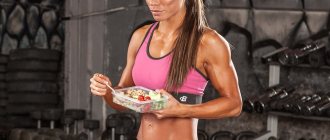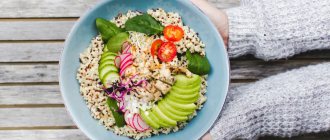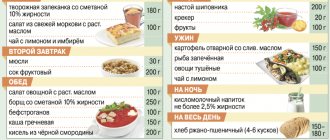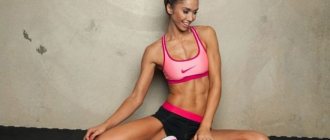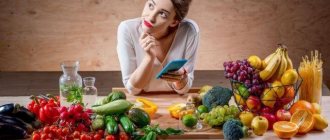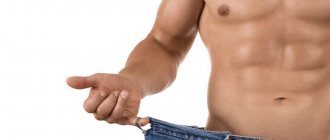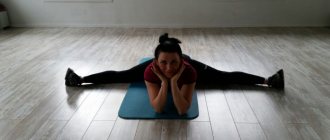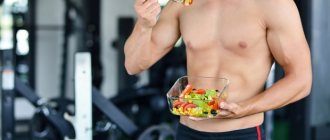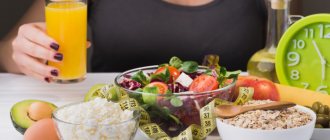A muscular, pumped-up body cannot be achieved without gaining muscle mass. You can build muscle if you have a well-chosen, correct menu. Training will not be important if there is no special material to work with.
For beginners, you need to prepare a daily menu that matches your goals. By building the basics of proper nutrition and creating an optimal diet, you can achieve quick results.
What a diet plan should include and what you need to gain weight will be discussed below in the article.
Basic diet rules for gaining muscle mass
During intense training and physical activity, a significant portion of energy is consumed. Costs are covered with food. By limiting your diet, a person will not receive enough substances necessary for weight gain.
The weight gain diet is based on one principle: you need to get more calories from food than you burn. Only by following this rule can you really achieve positive results.
You should also take into account the following several equally important menu rules for weight gain:
- Eat small meals. You need to eat 5-6 times a day. Portions are small. When eating a significant amount of food at one time, the body will not be able to digest all the nutrients. Some vitamins and minerals will be lost, and the muscles will not receive the required amount of energy on time. The rest of the nutrients will be stored in fat deposits.
- There are high-calorie foods. You should eat frequently, high-calorie foods - 70% of the daily diet. If you eat low-calorie foods, your body will not have enough energy. You will have to increase the number of meals, and the digestive organs will be overloaded.
- Limit the consumption of fast carbohydrates and fats. Consumption of such foods leads to an increase in body fat. Fast carbohydrates are flour products, sweets, baked goods, and candies. The calorie content of the food is high and is absorbed instantly. The body does not have time to quickly waste the energy received. Humans need animal fats in limited quantities. Lard and sausages consumed in excess contribute to an increase in fat deposits.
- Consume 2.5-3 liters of water per day. Rapid weight gain is stressful for the body. Accelerated metabolism and increased metabolism require large amounts of fluid. Lack of water will cause disruption of the digestive tract and worsen overall health. Also, with dehydration, muscles will stop growing.
- Receive 70% of calories before 16:00. Afterwards, eat proteins - cottage cheese, eggs, fish. Fast carbohydrates and fats are eaten before 12:00 and are acceptable before training.
- Diet of athletes. Professional athletes eat 2 hours before exercise and 1 hour after. You should eat as well. Constant training and an enhanced diet will accelerate the process of muscle growth.
- Compliance with the principle of the “food pyramid”: 60% - carbohydrates, proteins - 30%, fats - 10%. Most of the carbohydrates consumed are cereals, potatoes, and fruits. Proteins can be obtained from sports nutrition containing protein in the required quantities. Fats – vegetable, animal – in minimal quantities.
For different ages
As a person ages, he spends less energy and consumes fewer calories. And young people, especially in adolescence, need more of them.
- For men at the age of 3 years, the norm corresponds to 1300 kcal and grows to 3000 kcal by the age of 18.
- For ages 65 and older, the rate decreases to 1900.
- For women, the maximum amount of calories needed is at age 18 (2500 kcal) and decreases to 1700 kcal at age 65 and older.
Daily value of calories, proteins, fats and carbohydrates
Muscle growth will occur with regular training and sufficient energy. Sports supplements will not provide the optimal amount of calories. To restore the body's strength and increase muscle mass, you need to consume a significant amount of proteins, fats, and carbohydrates.
It is convenient to calculate your daily calorie intake using the Lyle MacDonald formula. To do this, you need to multiply your own weight by 35.
For example, for a guy weighing 70 kg: 70 x 35 = 2450 kcal. The data is based on a thin man with a fast metabolism. By adding 10-20% to the resulting value, you get the caloric intake for weight gain: 2450 x 1.2 = 2940 kcal.
By consuming 2940 kcal per day, the expended energy will be restored, and muscles will gradually increase.
For men
- Protein is the basis for muscle growth. With constant strength training, the daily protein intake will be 1.5-2.5 grams per 1 kg of body weight. Minimum – 150 grams per day. For a guy weighing 70 kg, 175 grams is enough. protein to speed up weight gain. Start with a smaller amount and gradually increase the dose. A sudden introduction of a large amount of protein into the diet will stress the body. Choose animal sources of protein with low fat content: chicken fillet, low-fat fish, low-fat cottage cheese, eggs. Vegetable proteins contained in beans, lentils, sesame are absorbed in full when consumed together with animals. After sports activities, you can drink a protein shake.
- Carbohydrates are a source of vitality; a deficiency leads to depression, apathy, and weakness. When eating to gain muscle, you need 5-6 grams per 1 kg of weight. For a thin man - 420 grams per day. Two hours before training, consume slow carbohydrates (buckwheat, oatmeal, rice), an hour before, an hour after - fast ones.
- Fats are 1-2 grams per 1 kg of weight. Fat intake also depends on age category. Maximum daily dose: up to 28 years – 160 g;
- 29–39 years old – 150 g;
- category 40+ – 70 g.
For women
- With intense training, the body requires more protein. Insufficient protein will affect the condition of the skin, hair, and nails. The minimum daily intake is 1.5 grams per 1 kg of weight: 50 kg – 75 g.
- 55 kg – 83 g.
- 60 kg – 90 g.
- up to 27 years – 118 g.
AT THE START
Age 35 years, height 170 cm, weight 67 kg.
5.2% and 94.8% – fat to muscle ratio. Wittrock took measurements using a BOD POD, the most accurate device available to date for determining the ratio of fat to muscle in the body. A person sits inside a special container and after a few minutes receives the parameters of his body.
Before the experiment, Jason's average daily calorie intake was 2,000 calories.
His BPJU for 4000 calories for 21 days looked like this:
- 75-80% – fats (300-350 grams),
- 15-20% – proteins (150-200 grams),
- 5% – no carbohydrates (50-70 grams)
The diet consisted of: eggs, avocados, fatty meats, low-carb nuts (macadamia, almonds, pecans), red fish, cheeses, green vegetables (spinach, celery, various types of greens), fatty sauces, “bulletproof” coffee (a mixture of coffee with heavy cream, butter and coconut oil) and, of course, oils - butter, coconut, macadamia, avocado.
Jason continued to train at his usual rhythm: 5 strength exercises per week, interval training according to the Tabata protocol, and abdominal exercises.
The Best Foods for Gaining Muscle
An increase in muscle mass is associated with the frequency of meals, caloric content and quality of foods consumed. You cannot save money; an unbalanced diet will have a detrimental effect on the condition of the body as a whole.
Recommended to use:
- Beef is rich in iron, keratin, and protein. Ideal – 200 grams per day, 2 times 100 g.
- Chicken fillet, breast. 300 grams contain 69 g of protein, i.e. half the daily requirement. Use 2-3 times a day in portions.
- Salmon contains protein and amino acids. Promotes recovery after training, reduces muscle inflammation, helps monitor testosterone levels.
- Eggs . When gaining weight, they are second only to a protein shake. Protein is instantly absorbed, breaking down into amino acids. To create a balance between proteins and fats, you need to remove 4 yolks from 6 eggs. This omelet will give the body up to 30 grams of protein.
- Nuts . Mono fats increase the performance of the heart, internal organs, and ligaments. You need to eat about 55-60 grams of various nuts per day: almonds;
- walnuts;
- peanut;
- hazelnut;
- cashew nuts.
- potassium;
How to eat on 2000 calories
The Food and Drug Administration considers the daily value of calories to be 2,000, which is the amount of nutrients most people need. So what does a 2,000 calorie diet look like?
Fruits and vegetables
If you're aiming to eat 2,000 calories a day, you'll need: 2 cups fruit, 2 1/2 cups vegetables.
What the daily norm might look like:
- 1 medium apple
- + 1 cup berries
- + 12 carrots
- + 1 cup cooked vegetables
Grains
If you're aiming to eat 2,000 calories a day, you'll need: 6 ounces of grain equivalents (1 ounce = 28 g).
What the daily norm might look like:
- 1 English muffin
- + 12 cm flatbread
- + 1 slice of bread
- + 1 cup rice
Low-fat dairy products
If you're aiming to eat 2,000 calories a day, you'll need: 3 cups of nonfat dairy.
What the daily norm might look like:
- 1 cup milk or soy milk
- + 1 glass of kefir
- + 1/3 cup grated cheese
Protein
If you're aiming to eat 2,000 calories a day, you'll need: 5 1/2 ounces equivalents.
What the daily norm might look like:
- 85g cooked salmon, chicken or beef
- + 12 pcs. almonds
- + 1/4 cup cooked beans
Trans fats and sugar
Ideally, give up sugar. But if you find it difficult to do this, stick to the daily limit recommended by experts. If you're aiming to eat 2,000 calories a day, you'll need: No more than 258 calories of these foods.
What the daily norm might look like:
- 60 g sweet bar or glazed donut
Oils and salt
If you're aiming to eat 2000 calories a day, you'll need: 27g butter and 2300mg salt.
What the daily norm might look like:
- 5 1/2 tsp. oils
- 1 tsp. table salt
Weekly menu for gaining muscle mass
Nutrition for muscle growth must be complete, high-quality, fractional. The diet consists of 3 main meals and 2 snacks.
Features of the menu for weight gain:
- Calorie content – 3000 kcal.
- Water – 3 liters/day.
- Avoid sweets.
An approximate menu option is presented in the table:
| Day of the week | Menu |
| Monday | Breakfast: oatmeal with apples, nuts, toast with cheese, tea. Snack: dried fruits. Lunch: chicken fillet, potatoes, vegetable salad, bread, butter. Afternoon snack: banana, cottage cheese. Dinner: baked salmon, rice, vegetable plate. 30 minutes before bedtime: kefir. |
| Tuesday | Breakfast: Buckwheat porridge with fruits, almonds, milk, bread. Snack: cottage cheese, sour cream, honey. Lunch: cabbage soup with beef, mackerel, baked with vegetables. Afternoon snack: homemade yogurt, bread. Dinner: boiled chicken breast, potatoes, vegetables. 30 minutes before bedtime: kefir. |
| Wednesday | Breakfast: rice milk porridge, 6 egg omelette. Snack: yogurt, raspberries. Lunch: stewed turkey fillet, durum pasta, butter, tomatoes. Afternoon snack: toast with cheese, cottage cheese with jam. Dinner: river trout, brown rice, vegetable salad, sour cream. 30 minutes before bedtime: milk. |
| Thursday | Breakfast: omelette, chicken fillet, steamed vegetables. Snack: smoothie made from milk, banana, strawberries, peanuts. Lunch: boiled veal, grilled vegetables, potatoes. Afternoon snack: salmon sandwich, tomato juice. Dinner: vegetable stew, flounder, peppers, cucumbers. 30 minutes before bed: yogurt. |
| Friday | Breakfast: milk pasta soup, eggs - 2 pcs, cheese, bread, butter. Snack: milkshake, cottage cheese. Lunch: borscht with beef broth, beef, sautéed vegetables, buckwheat. Afternoon snack: nuts, dried fruits, banana. Dinner: mackerel, potatoes, sliced vegetables. 30 minutes before bedtime: kefir. |
| Saturday | Breakfast: oatmeal, milk, banana, strawberries, bread. Snack: cheesecake, homemade yogurt. Lunch: solyanka, vegetables baked with chicken, bread. Afternoon snack: milk smoothie, cottage cheese. Dinner: rice, baked salmon, vegetable salad. 30 minutes before bedtime: kefir. |
| Sunday | Breakfast: buckwheat porridge, omelette, bread. Snack: cottage cheese casserole. Lunch: vegetable soup, veal, pasta, cucumber. Afternoon snack: cottage cheese, jam, kiwi. Dinner: rice, chicken breast, steamed beets. 30 minutes before bed: homemade yogurt. |
How to eat on 3000 calories
If you're looking to get down to 3,000 calories a day, chances are you're underweight or trying to gain muscle mass. Active adult men ages 19 to 35 need 3,000 calories per day to maintain a healthy body weight, according to dietary recommendations.
Eat frequently—every few hours—and choose nutritious, high-calorie foods.
3000 calorie meal plan
- 4 cups vegetables
- 2.5 cups fruit
- 200 g protein products
- 280 g grains
- 3 cups dairy products
- 10 teaspoons oil
- 459 additional calories from foods of your choice
Protein
If you're aiming to eat 3,000 calories a day, you'll need: 200 grams of protein foods (eggs, lean meats, poultry, seafood and soy products).
What does one serving look like (=28 g):
- One egg
- 1.5 egg whites
- 28 g meat, fish or poultry
- 14 g nuts or seeds
- 1 tbsp. l. nut butter
- one quarter cup of legumes
- half a veggie hamburger or a quarter cup of tofu
Dairy
If you're aiming to eat 3,000 calories a day, you'll need: 3 cups of dairy.
What does one serving look like:
- 1 cup milk, yogurt or soy milk
- 2 cups cottage cheese or 42 g hard cheese
Grains
If you're aiming to eat 3,000 calories a day, you'll need: 280 grams of grain.
What does one serving look like (=28 g):
- One slice of bread
- 1 cup ready-to-eat grains or 1/2 cup cooked rice, pasta, or oatmeal
Fruits
If you're aiming to eat 3,000 calories a day, you'll need: 2.5 cups of fruit.
What does one serving (1 cup) look like:
- 1 cup fruit juice
- 1 cup fresh fruit or 1/2 cup dried fruit
Vegetables
If you're aiming to eat 3,000 calories a day, you'll need: 4 cups of fruit.
What does one serving (1 cup) look like:
- Cup of raw or cooked vegetables
- 2 cups leafy greens or 1 cup vegetable juice
Oils
If you're aiming to eat 3,000 calories a day, you'll need: 10 teaspoons of oil.
What does one serving (1 teaspoon of a group of oils) look like:
- 1 tsp. vegetable oil
- 1 tbsp. l. Italian salad dressing
- 1.5 tsp. nut butter or 9 g nuts (or seeds)
Sample menu
Breakfast
- two slices of whole grain toast with 1 tbsp. l. peanut butter
- 1 cup yogurt
- Two eggs
- 1/2 cup oatmeal
- 1 cup fresh strawberries
Morning snack
- 28 g almonds
- 1 cup fresh blueberries
Dinner
- 85 g grilled chicken breast
- 2 cups leafy greens
- 1/2 cup chopped cucumbers
- 1/2 cup cherry tomatoes
- 2 tbsp. l. Italian salad dressing
- 1 cup brown rice
Afternoon snack
- 1 cup low sodium vegetable juice
- 85 g low-fat cheese
- 1/4 cup raisins
- 10 whole grain crackers
Dinner
- 85 g grilled salmon
- 1 cup steamed broccoli
- 1 cup whole wheat pasta with 1 tbsp. olive oil pesto sauce
Evening snack
- 3 cups popcorn
- 1 cup kefir
- 28 g peanuts
Optimal time to eat
Nutrition is an important component when gaining muscle mass. Complete assimilation of the received elements will only occur if you adhere to the daily routine, rest, and training.
Before training starts
You should not eat food immediately before training. The optimal time is two hours before the start of classes.
You need to choose foods rich in complex carbohydrates. They will give you strength and energy for the upcoming workout. It is recommended to eat a plate of porridge, pasta, and potatoes. Supplement your meal with fruits, meat, and nuts. It is advisable to drink a cocktail containing proteins and carbohydrates 30 minutes before.
After completing training
Avoiding eating after training is prohibited. This is the ideal moment to fully absorb all the elements necessary to build muscles.
45 minutes after the end of the lesson, you need to eat a few bananas and drink a portion of gainer. The main thing is to replenish lost energy and restore strength. Include foods containing proteins and slow carbohydrates in your diet.
Meal frequency
It is necessary to eat with breaks not exceeding three hours. Eat fully five to six times. An important point is the number of meals and recommended meal times.
The ideal schedule for gaining muscle is presented below:
- Breakfast – 7:00.
- First snack – 11:00.
- Dinner – 14:00.
- Afternoon snack – 17:00.
- Dinner – 20:00.
- Meal before bed – 23:00.
The serving size depends on the characteristics of the body, but the daily calorie content is not less than 1500 kcal for girls, 2500 kcal for boys.
By building your optimal nutrition schedule, you can achieve great results. By following this diet for 90 days, you will develop a reflexive desire to eat by a certain time.
Sample menu by day
A menu for a week with five meals a day might look like this:
Monday
- 7.00 Millet porridge with pumpkin, nuts, honey. Cottage cheese (420g, 534 kcal B-28g, Zh-12g, U-77g).
- 11.00 Casserole with raisins and walnuts. Korean-style carrots with chuka (150/20/150 320g, 578 kcal B-16.3g, Zh-35.2g, U-49.1).
- 14.00 Bolognese pasta and Korean-style carrots with chuka (100/150/150 400g, 634 kcal B-20.7g, Zh-32g, U-65.8g).
- 17.00 Cheesecakes with cherries, yogurt, cream sauce (190g, 465 kcal B-12.7g, Zh-18.3g, U-64.2g).
- 20.00 Steamed chicken cutlets with buckwheat, broccoli and yogurt (270g, 367 kcal B-31.8g, F-11.4g, U-34.2g).
Tuesday
- 7.00 Pumpkin pancakes with apple sauce (240g, 500 kcal B-7.4g, F-22.4g, U-67.4g).
- 11.00 Chocolate muffins with peanut butter (220g, 501 kcal B-26.7g, Zh-17g, U-59.5g).
- 14.00 Baked minced turkey with sun-dried tomatoes and jasmine rice (270g, 502 kcal B-20.3g, F-18.4g, U-63.7g).
- 17.00 Chicken breast salad, cottage cheese (320g, 438 kcal B-33.9g, F-22.8g, U-21.6g).
- 20.00 Vitamin salad with pumpkin seeds and Green sauce (170g, 354 kcal B-2.6g, F-32.7g, U-12g).
Wednesday
- 7.00 White omelette, beans, tomatoes. Rice pudding with almonds (270g, 562 kcal B-35.5g, F-29.4g, U-38.9g).
- 11.00 Sandwich with chicken breast, baked pepper and Korean carrots (320g, 605 kcal B-36.4g, F-31.1g, U-44.5g).
- 14.00 Turkey lula kebab with baked potatoes (290g, 574 kcal B-31.8g, F-28.7g, U-45.4g).
- 17.00 Salad with seafood, creamy mustard sauce and protein omelette with herbs (320g, 478 kcal B-24.4g, F-32.4g, U-19.1g).
- 20.00 Grilled chicken breast with broccoli and yogurt with herbs (310g, 327 kcal B-31.9g, F-17.1g, U-12.7g).
Thursday
- 7.00 Pancakes with minced chicken (190g, 452 kcal B-27.8g, F-25.6g, U-58.6g).
- 11.00 Cheesecakes with cherries, Omelette with chicken breast and creamy mustard sauce (360g, 553 kcal B-53.3g, F-29.8g, U-16.8g).
- 14.00 Beef hedgehog with pasta with barbecue sauce (270g, 548 kcal B-29.2g, F-14.8g, U-74.3g).
- 17.00 Vegetable salad with turkey in sesame seeds and protein omelette with broccoli (340g, 498 kcal B-30.9g, F-32.8g, U-21.5g).
- 20.00 Steamed chicken breast, with green beans (270g, 396 kcal B-34.1g, F-17.8g, U-24.9g).
Friday
- 7.00 Omelet with vegetables, creamy mushroom sauce, cottage cheese (340g, 565 kcal B-50.8g, F-29.3g, U-19.4g)
- 11.00 Salad with squid, vegetables. Curd casserole (300g, 520 kcal B-43g, Zh-24g, U-28g)
- 14.00 Grilled chicken breast with buckwheat, green beans (290g, 539 kcal B-30.4g, F-28g, U-41.4g)
- 17.00 Broccoli salad with vegetables and cottage cheese casserole, hazelnuts (320g, 507 kcal B-26.4g, F-32.1g, U-32.4g)
- 20.00 Salad with seafood and vegetables (150g, 298 kcal B-12g, Zh-22g, U-10g)
Saturday
- 7.00 Omelet with chicken and tomato with creamy tomato sauce, cottage cheese (340g, 514 kcal B-38.4g, F-30.6g, U-18.7g).
- 11.00 Vegetable salad with turkey, creamy mustard sauce, cottage cheese with strawberries (320g, 550 kcal B-36.6g, F-31.5g, U-28.3g).
- 14.00 Lasagna Bolognese (260g, 541 kcal B-23.3g, F-32.4g, U-32.7g).
- 17.00 Vitamin salad with pumpkin seeds, banana-oat muffins with strawberry jam (370g, 496 kcal B-6.5g, F-24.7g, U-61.8g).
- 20.00 Salad of fresh cucumbers, red onions with olive oil (140g, 319 kcal B-1.2g, Zh-33g, U-2.2g).
Sunday
- 7.00 Oatmeal porridge with dried fruits and dried apricots, prunes, almonds, walnuts (330g, 544 kcal B-13.5g, F-26.4g, U-77.7g).
- 11.00 Greek salad with Feta cheese, cottage cheese casserole with raisins, walnuts (300g, 572 kcal B-24g, F-36g, U-38g).
- 14.00 Steamed beef cutlets with baked potatoes and creamy mushroom sauce (290g, 556 kcal B-45.9g, F-21.8g, U-43.7g).
- 17.00 Pumpkin pancakes with apple sauce (240g, 500 kcal B-7.4g, F-22.4g, U-67.4g).
- 20.00 Chicken zrazy with mozzarella, buckwheat and broccoli (250g, 363 kcal B-34.3g, F-10.6g, U-32.6g).
Water and its role
Water is an important component when gaining weight. Liquid occupies 65% of the total volume of biologically significant substances. To maintain the balance of H2O in the bodybuilder’s body, you need to consume as much as is lost during the day.
For girls - 2 liters, for guys - 2-2.5 liters.
Drink mineral water without gas, purified, boiled pipeline water.
Water comes in:
- Directly when consumed with liquid — 60%.
- With food (soup, borscht, porridge) — 30%.
- During the digestion process — 10%.
Functions of water
The main functions of water during sports activities:
- Supports organ function. Water carries nutrients to cells, participates in the process of digestion, digestion, and muscle fiber growth.
- Thermoregulation. During training, 75% of the fluid is used for heat exchange, the body produces sweat, which cools. 25% of water is lost during exercise. Up to 2 liters of H2O is lost through sweat in 60 minutes.
- Burning fat deposits. When gaining weight, it is important that the calories gained are converted into muscle and not stored as fat. Drinking half a liter of water 4 times a day can burn up to 100 calories.
- The appearance of activity during training. Dehydration leads to a feeling of fatigue and powerlessness. Water starts processes in muscles due to its significant content in muscle fibers.
- Improving execution technique and accuracy of movements. As a result of a lack of fluid, an incomplete exchange between nerve and muscle tissues will occur. A lack of 3% H2O can reduce aerobic activity by half and training efficiency by 20%. Sufficient fluid intake promotes rapid muscle growth.
- Lubrication of the joint-ligamentous apparatus. During intense training, the load is also placed on the joints. There is always fluid in the ligaments and joints, the flow of which is related to the amount of water drunk. The appearance of thirst indicates a lack of moisture in the body. If you feel the feeling, immediately drink 400 ml of water.
- Water removes fluid from the body. With a constant lack of H2O, the body begins to store it for future use, storing liquid in fatty deposits. Accordingly, the weight goes not into muscles, but into fat.
The required volume of liquid is calculated using the formula: body weight multiplied by 30. With a weight of 70 kg, you need to consume 70x30 = 2100, i.e. 2.1 liters of water per day.
Rules for water consumption:
- Drink 400 ml of liquid 90-120 minutes before training, 200 ml 30 minutes before training. Increase the volume to 800/400 ml in the hot season.
- During exercise, consume 250 ml of liquid every 15 minutes. Per hour of training - up to 1 liter for men, 600 ml - for women. For professional bodybuilders, increase the volume to two liters of water.
- After exercise, you also need to replenish the lost volume of H2O - drink 400-700 ml over two hours.
Who can consume 4000 calories?
As shown above, eating 4,000 calories daily will likely be quite difficult for the average man or woman. However, as with everything in life, there are exceptions to this rule. They are as follows:
1. Bodybuilders. When preparing for competition, a 200-pound bodybuilder might consume 4,000 calories per day as a bulk diet to maximize muscle growth.
2. Basketball, football and rugby players. They can consume between 3,000 and 4,500 calories per day.
3. Endurance athletes such as cyclists, swimmers, marathon runners, rowers, etc. Depending on the type and intensity of the sport, these athletes can consume 3,000 to 8,000 calories per day or more. Olympic champion Michael Phelps once admitted that he eats 12,000 calories a day before Olympic competition.
List of recommended protein foods
Protein foods are essential for gaining muscle mass.
The best options are recognized:
- Cottage cheese. The fermented milk product contains 20% fast and slow proteins, which are absorbed alternately.
- Meat ingredients: chicken, turkey, beef. They consist mostly of proteins. Almost completely absorbed. Use boiled, steamed or stewed.
- Salmon. Accelerates the metabolic process, increases the growth rate of muscle fibers.
- Fish fat. Normalizes metabolism, is an anti-inflammatory agent, supports the functioning of organs after training.
- Eggs are an optimally balanced food for training.
- Buckwheat porridge. Positively affects muscle growth.
- Milk. Well digestible, contains a lot of protein.
- Fermented milk products: homemade yogurt, kefir.
- Salmon, lean fish. Rich in omega-3 fatty acids necessary for the functioning of the body.
- Sunflower seeds, sesame.
- Fresh tuna.
- Lentils.
Important points for a calorie diet
Since the calculations are quite complex, it is recommended to prepare a menu for the week in advance. One of the most important points is five meals a day with calories calculated in the following ratio: breakfast - twenty-five percent, second breakfast - ten percent, lunch - within thirty percent, afternoon snack - up to twenty-five percent, dinner - ten percent.
To ensure that the body does not suffer from the lack of vital substances, it is necessary to include five food groups in the diet:
- polyunsaturated fats;
- fruits;
- cereals;
- proteins;
- vegetables.
List of carbohydrate products
Carbohydrate foods should account for more than half of all food consumed. You need to use slow carbohydrates in food, and try to eliminate fast ones as much as possible.
You can get it from:
- Mushrooms.
- Cereals.
- Durum pasta.
- Legumes: beans, chickpeas, peas.
- Brown rice
- Potato.
- Vegetables.
- Bread.
- Greenery.
- Garlic.
- Fruits, excluding grapes, pears.
It is better to eat the above foods in the first half of the day, 1.5 hours before training. Some carbohydrates can be replaced with a cocktail immediately after training.
List of foods containing fats:
- Almond.
- Cashew nuts.
- Walnut.
- Brazilian nut.
- Hazelnut.
- Mackerel.
- Applesauce pastille.
- Sardines.
- Anchovy.
- Salmon.
- Red meat.
- Ghee, butter.
- Sour cream.
- Cream.
- Salo.
- Crackers, homemade chips.
- Cheese.
- Sausage, balyk.
What foods should you include in your diet?
It is not enough to create a high-calorie menu; it must include healthy foods that are well absorbed by the body. And don’t forget about the correct proportion of nutrients.
High carbohydrate foods:
Black bread
- Porridge.
- Noodles.
- Cereals.
- Mushrooms.
- Potato.
- Pasta.
- Hazelnuts and walnuts.
- Apricot seeds.
- Muesli.
High fat foods:
- Fish (salmon, sardines, anchovies).
- Butter.
- Walnuts.
- Sour cream.
- Cheeses.
- Melted butter.
- Cream.
High protein foods:
- Eggs.
- Boiled and fried fish.
- Yogurt and cottage cheese.
- Kefir.
- Peas, beans, beans.
- Beef.
- Mutton.
Nutritional features for gaining lean muscle mass
There are several types of cutting diets:
- Carbohydrate – comes down to limiting the intake of any carbohydrates. It is allowed to eat meat, fish, eggs, green vegetables, fermented milk dishes, and purified water.
- The zone diet is suitable for bodybuilders who train intensively while cutting. The diet is divided into protein, fat, carbohydrate meals alternately and several snacks.
- Paleo diet. The menu includes only natural, unprocessed foods: vegetables, fruits, berries, nuts. Milk, cereals, and sugar are excluded.
- Fractional meals. You need to eat every 2 hours, up to 10 small meals per day. Follow the diet for 5 days, rest for 10 days, eating the same ingredients 5 times a day. This diet option for gaining lean mass is considered the most effective.
The rules of drying for men and women are different, so it is best to consider the features of the diet for each category separately.
Features of the drying diet for women
- It is recommended to consume complex carbohydrates in the amount of 35-40% of the daily diet.
- Fats of 15-20% will help you avoid problems with hormonal levels and the menstrual cycle.
- The basis of nutrition is proteins up to 60%.
- You can suppress the feeling of hunger by using foods rich in fiber: cabbage, bran, zucchini.
- During intensive training, increase water consumption to 2.5 liters per day.
- By gradually reducing the amount of carbohydrate-containing foods, you can really avoid stress for the body. Replace sweets and confectionery with cereals, fruits, and dried fruits.
- 60 minutes before training, you are allowed to drink only sports supplements rich in proteins and carbohydrates.
- Proper weight loss is 2 kg per week. Exceeding the value indicates a decrease in muscle mass; fluid is lost, not fat deposits.
- Eat food 6 times a day in fractional portions with breaks of 2.5-3 hours.
Features of the girls' body:
- Low metabolism. When eating a high-calorie diet, a woman will gain excess weight faster than a man;
- A special storage mechanism in case of pregnancy and childbirth with an excess of carbohydrates will lead to the appearance of fat folds;
- The advantage of the female body is that stored fat, with the right diet in combination with training, will easily turn into muscles;
- The muscle corset is more developed in the lower part. Although changes during drying will be more visible in the area of the arms, face, waist, and chest. Lastly, relief will appear on the legs and hips.
Features of a diet for drying in men
Nutritional features for gaining lean muscle mass for men:
- The diet must be correct . You should consume twice as much carbohydrates as proteins. The optimal ratio of carbohydrates, proteins, fats is 40-30-30.
- There are a sufficient number of foods containing fiber and plant fibers . For example, cabbage, blueberries, legumes.
- Calorie content should not be lower than 2000 kcal. Lower values will result in decreased testosterone. The excess is easy to spend at the gym.
- Water removes toxic substances produced from protein foods from the body. The norm is 3 liters in the cold season, up to 5 liters in the summer.
- The calorie content of each meal is not higher than 450-500 kcal.
The characteristics of the male body are determined by testosterone, a hormone:
- Accelerates muscle growth.
- Affects protein synthesis.
- Affects the distribution of fat deposits.
- Slows down aging.
About 10 milligrams of the hormone are produced per day. You can increase its volume only with proper nutrition, a selected diet, and proper exercise. The use of hormonal drugs will increase endurance, increase muscle mass, but can lead to dysfunction of the male reproductive organ.
Dehydration
To look as natural as possible in the role of Wolverine, the actor had to dry his body and consume a minimum of water. Hugh himself warns against this, saying that it is not very healthy.
“First you increase your water consumption,” he says. — Every day you need to drink 5-10 liters. You stop drinking 36 hours before filming, but you still have to make frequent trips to the bathroom. You get as close to dehydration as you can and then put on your claws. The effect is, of course, noticeable, but it happens at the limit of the body’s capabilities.”
Jackman also said that when he first signed on to play Wolverine in 2000, he underestimated how long it would take to get into shape. He expected that he would be able to do everything in three weeks, but he soon realized that this was not the case. "If you turn on the first film, there are some awkward shots that don't do my discipline at the time any credit," Hugh said. He also admitted that after filming “Logan” ended, he ate all the time, unable to stop.
